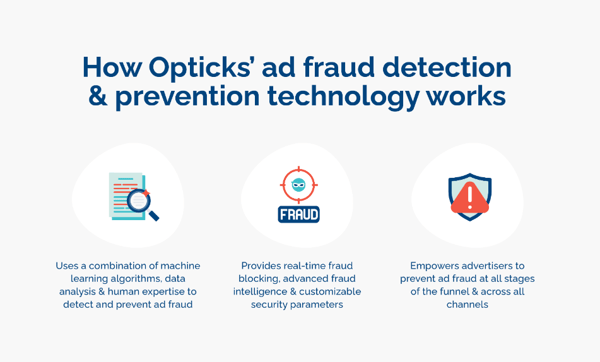Ad Fraud Prevention Technology vs. Ad Fraudsters' Latest Tech

 By
Eduardo Aznar
·
5 minute read
By
Eduardo Aznar
·
5 minute read
Ad fraud is like a game of cat and mouse. Fraudsters use ever-evolving tactics, techniques, and technology to perform ad fraud, profit from it, and circumvent traditional ad fraud protection measures to stay ahead.
However, those battling it are also upping their game, with advertisers leveraging the latest ad fraud detection technology to fight back. In this article, we unveil the latest methods fraudsters are using and the sophisticated ad fraud prevention technology that gives you the best chance of countering them.
- How fraudsters use technology to perform ad fraud
- The rising cost of ad fraud
- The role of ad fraud detection technology
- The future of ad fraud prevention
- How Opticks uses technology to detect & prevent ad fraud
- Future-proof your organization with ad fraud prevention technology
How fraudsters use technology to perform ad fraud
Ad fraud is sophisticated. Many of the biggest ad fraud cases in recent years demonstrate just how quickly fraudsters can scale their operations and defraud even the most well-known enterprises.
Fraudsters view your ad campaigns as a challenge: If at first they don’t succeed, they’ll develop their technology to easily sidestep the basic countermeasures you have in place (e.g. CAPTCHA tools and IP block lists) to prevent them from draining your budgets.
However, they’re also using technology they use to perform various types of ad fraud intended to capture your ad budgets. Let’s take a look at the types of ad fraud and the technology fraudsters use to carry them out.
Click fraud
Although individuals can perform click fraud (fraudulent publishers and competitors are the usual suspects), fraudsters also use computer programs and generated scripts to repeatedly click on pay-per-click (PPC) advertisements to deplete budgets.
Click fraud is usually performed using automated scripts run by malicious click bots, botnets, and also by people hired to work in click farms.
- Click bots have been coded to click on PPC ads. Fraudsters embed click bots onto devices, servers, and data centers to host low-quality websites or apps. The bots will then click on as many ads as possible, and collect the payout for paid-ad clicks.
- Botnets operated by fraudsters are networks of multiple devices that have been infected with malware. They’re often operated by remote threat actors and connected by a common piece of code. Botnets partially override web browsers on infected devices to direct fraudulent clicks on online ads.
- Click farms are made up of individuals manually clicking on ads repeatedly. However, in order to gain access to the higher financial rewards offered by PPC campaigns in regions like the U.S., fraudsters operating click farms use VPNs and proxy traffic to mask their locations and evade campaign location rules.
Use of all of these types of technology results in the same outcome: Advertisers are charged for clicks that are not genuine.
Impression fraud
To perform impression fraud, fraudsters use pixel stuffing and ad stacking to insert invisible ads into a webpage. Although the ads are hidden from the naked eye, the impressions that the ad receives are still counted, and advertisers are still charged. Impression fraud usually targets display ads and video ads.- Pixel stuffing involves embedding a normal-looking ad with a fraudulent pixel that is “stuffed” with many ads, often with the use of bad bots. Although the end-user cannot see the pixel, they are viewing multiple ads at once, which means fraudsters receive compensation for countless illegitimate impressions.
- Ad stacking occurs when fraudsters layer multiple ads on top of one other in the same ad placement. Only the ad on top is visible to the user, yet advertisers are charged for all of the false ad impressions from all stacked ads.
Conversion fraud
There are three common types of conversion fraud: attribution fraud, install fraud, and lead fraud.
Attribution fraud
Attribution fraud occurs when fraudsters use malware that’s installed on devices to steal credit for legitimate leads.
Fraudsters use invalid clicks to steal the “last engagement” just before an app is opened by a real user.
Install fraud
Install fraud involves fraudsters generating fake app installations. They do this via illegal malware downloaded onto a device, via device emulators, and through click injections.
- Device emulators are programmed to perform repetitive, automated tasks such as fake clicks to download applications.
- Click injections work when fraudsters either publish or have access to a downloaded app that listens to “install broadcasts” and send fake clicks just before an install is completed to receive compensation for the installation.
Lead fraud
Lead fraud occurs in cost-per-lead advertising when lead providers use fraudulent lead generation methods for financial gain.
This can be done through illegal contact information lists or specially designed bots that fill out lead generation forms with stolen or fraudulent information. Fraudsters may also use VPN proxy traffic to generate fake leads from targeted Tier 1 targets.
The rising cost of ad fraud
While global digital ad spending is predicted to surpass $626 billion in 2023, ad fraud continues to cost the advertising industry a colossal $100 billion.
On top of these eye-watering figures, ad fraud also has implications for advertisers’ most important KPIs. Research shows that ad fraud causes an 11% reduction in Return On Ad Spend (ROAS) and a 9% increase in Customer Acquisition Cost (CAC).
This represents a huge burden on the advertising industry -- and even more so as the world faces a possible recession, since there will be fewer advertising resources available for advertisers to both achieve their goals and tackle ad fraud.
Ad fraud does more than just drain budgets, resources, and revenue: For advertisers and publishers alike, it also leads to an erosion of trust and reputational damage across the industry. From a decrease in the trustworthiness of platforms and advertisers among customers to a wariness of publishers, ad fraud has a damning effect on all stakeholders.
👉 Read more: 2022 Ad Fraud Report: Summary of Key Findings for Advertisers
Ad fraud prevention providers: The role of ad fraud detection technology
There is, however, an upside to be told when it comes to innovative technology available to advertisers and marketers. There are ample ad fraud prevention technology providers using robust technology to detect and prevent ad fraud with an arsenal of tools powered by artificial intelligence and machine learning algorithms.
In particular, machine learning engines can analyze vast amounts of data to identify patterns and anomalies that indicate fraudulent activity. This can be done in real-time, allowing for quick and accurate detection of ad fraud.
As quick as fraudsters can be, ad fraud detection technology is quicker. Anti-ad fraud prevention solutions like Opticks use a combination of multiple technologies, including machine learning algorithms, to not only provide comprehensive protection against ad fraud but in turn, to help bolster the performance of ad campaigns.
The future of ad fraud prevention
Ad fraud prevention technology is constantly advancing to meet and overcome the scale of fraudulent operations.
Blockchain, for example, is an up-and-coming tool being leveraged in the fight against ad fraud. Automotive manufacturer Toyota has already invested in blockchain-based advertising in a bid to eliminate fraud when buying digital ads.
With its ability to offer higher levels of transparency and security, blockchain is well-poised to prevent ad fraud. In fact, blockchains, with their decentralized peer-to-peer networks, provide enhanced safety and security for data, as there is no single point of failure or access point for malicious hackers. For example, it can help verify that ads are not manipulated and establish complete traceability of each ad impression.
While the use of machine learning and artificial intelligence is prevailing in terms of ad fraud detection and prevention, new methods like blockchain are on the rise which will shape the future of the industry as a whole.
How Opticks uses technology to detect and prevent ad fraud

Ad fraud prevention technology provider Opticks uses a combination of machine learning algorithms, data analysis, and human expertise to detect and prevent ad fraud.
The platform’s key features, such as real-time fraud detection across all advertising channels and across the entire advertising funnel, real-time fraud blocking, advanced fraud intelligence, and customizable security parameters, make it the most effective ad fraud prevention solution on the market.
With Opticks, advertisers are able to use the most sophisticated ad fraud prevention technology to block ad fraud at all stages of the funnel across all channels. On top of that, it also enables them to boost their growth, achieve their revenue targets, and access granular insights into their ad performance to enable them to make optimized decisions.
Future-proof your organization with advanced ad fraud prevention technology
As digital media continues to dominate advertising budgets, fraudsters’ use of technology to perform ad fraud persists as one of the biggest obstacles that advertisers need to tackle.
However, thanks to sophisticated ad fraud prevention technology providers, advertisers are better-poised than ever to tackle the problem head-on.
Opticks has the experience, expertise, and technology to keep ad fraud at bay and protect your campaigns and budgets by proactively preventing ad fraud. Our holistic, end-to-end solution ensures that all your campaigns and advertising efforts are safeguarded from the get-go.
To learn more about how the expert team at Opticks stays ahead of the curve and uses the most advanced technology and techniques to prevent ad fraud, schedule a free demo now.
